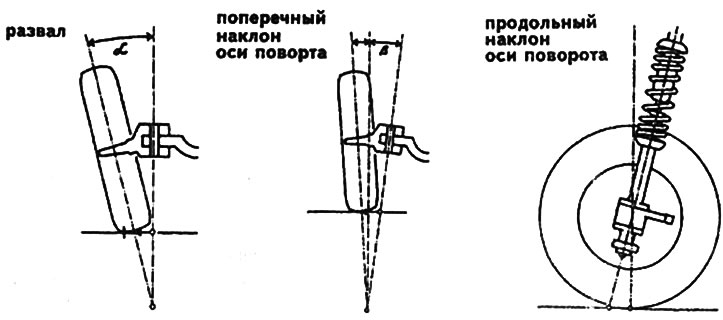Optical measurements require special equipment. Only the basic concepts related to the measurement process and adjustment parameters are described here.
Convergence. collapse. Transverse and longitudinal inclination of the axis of rotation
Toe-in is the difference in distance between the rear and front edges of the wheels at axle level and measured transversely. As a rule, the front wheels have a positive convergence, which prevents the wheels from moving apart due to their camber and rolling resistance in a straight line. The reason for the discrepancy of the wheels are also backlashes in the wheel bearings, suspension and steering rod joints. The convergence of the front wheels compensates for their tendency to diverge.
Camber and lateral tilt reduce steering input and reduce wheel friction when cornering.
The camber is the angle of deviation of the wheel plane from the vertical. As a result of the collapse of the wheels, they are inclined. In particular, with negative camber, the distance between the wheels at the points of their support on the ground is greater than at the top.
The transverse inclination of the axis of rotation is the angle between the axis of the steering knuckle and the vertical in the transverse direction along the car.
Due to the presence of camber and the transverse inclination of the axis of rotation, the points of contact of the wheels with the roadbed become closer to the axis of the steering knuckle. This maintains a small value of the steering gear running-in leverage. The smaller it is, the less resistance to turning. At the same time, the transmission of roadway impacts to the steering mechanism is weakened.
The longitudinal inclination of the axis of rotation is the angle between the axis of the steering knuckle and the vertical in the longitudinal direction of the car. A low caster angle reduces the vehicle's stability when driving on bad roads or with crosswinds and makes it difficult to return the steering to its original position. At the same time, an excessively large longitudinal inclination increases the force applied to the steering wheel.
The longitudinal and transverse inclinations of the axes of rotation and the camber of the TOYOTA COROLLA car are not regulated, but only controlled. Deviation of the indicated values from the specified values indicates the presence of damage in the suspension or wear of parts.

Adjustment
To carry out geometric control of the chassis of the car, an equipped pit or lift is required. To carry out this operation, the following conditions must be met:
- Tire pressure must be correct
- The fuel tank must be full, but the car must be without passengers and the driver
- The vehicle's suspension must be seated by applying force from top to bottom
- The steering wheel must be in the middle position («directly»)
- Steering wheel play must be within tolerance (play of the steering wheel rim no more than 30 mm)
- The play in the suspension and in the wheel bearings must be within tolerance.
- Radial and axial runout of wheel disks should not exceed 1 mm
- Clearance (ground clearance) must match the given value
